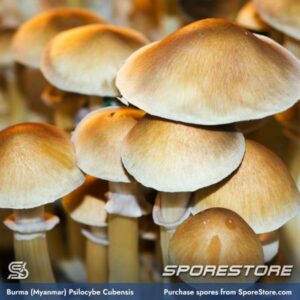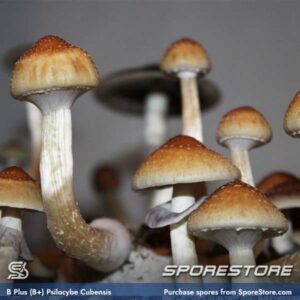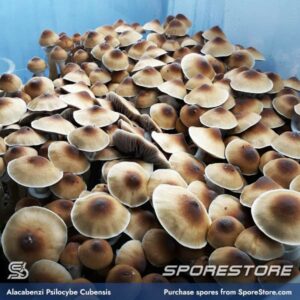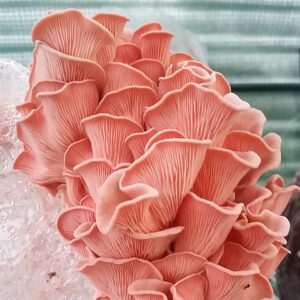-
Burma Spores
Burma Spores
Burma Spores mushrooms and their spores are also some of the most sought after psilocybe cubensis magic mushrooms ever found. Spores from the Burma Spores mushroom are available here at SporeStore.com because you asked for them! Find both mushroom spore syringes and also mushroom spore prints. This psilocybe cubensis magic mushroom was first discovered on a farm growing in a pile of dung and straw as its mushroom substrate in Burma. There is no psilocybin or psilocin contained within magic mushroom spores, making them completely legal to purchase and posses in most jurisdictions throughout the USA. As well as make sure to check your local laws before ordering. The original Burma Spores mushroom spores’ genetics from the true Burma Spores psilocybe cubensis mushrooms from Burma are brought to you by SporeStore.com, the leader in mushroom spores.
Spores from this strain are in abundance as it’s a healthy spore depositor.
Burma Spores magic mushrooms are easy to grow. Check your local mushroom growing laws. Growing mushrooms for identification and taxonomy purposes? We have your spores!
In addition to the PES Amazonian Spores spores, here are some other mushroom spores that you may be interested in reviewing: Alacabenzi mushroom magic spores, B+ mushroom spores which is also called B Plus mushroom spores, Malaysia Spores mushroom spores, PES Hawaiian mushroom spores, Ecuador spores
Furthermore check out our new Mushroom Grinder!
Mushroom Capsules found here…
More Detail:
Habitat: Bovine, Equine Dung and Enriched SoilsClimate: Subtropical
Strain Origin: Burma (Myanmar)
Cap: 50+ mm in diameter, convex to broadly convex to plane at maturity. Reddish cinnamon brown maturing to golden brown to light yellow because the surface is dry with pronounced and persistent remnants of universal veil on cap (spots) and the flesh is white soon bruising bluish green.
Stem: 125+ mm in length, yellowish. Flesh bruising bluish green where injured. Persistent membranous annulus (ring) from partial veil that becomes dusted with purple brown spores at maturity.
Gills: Attachment adnate to adnexed. Grayish coloration in young fruit bodies becoming nearly black in maturity.
Spores: Dark purplish brown, subellipsoid on 4-spored basidia
Storage: Store in a dark, cool and dry place and use within six months after delivery!
Taxonomy:
Kingdom: Fungi
Division: Basidiomycota
Class: Agaricomycetes
Order: Agaricales
Family: Strophariaceae
Genus: Psilocybe
Spores: purplish brown to dark brown, 11.5 – 17 x 8 – 11 µm, ellipsoidHabitat and distribution in nature:
Rye grain, wheat straw, horse or cow manure. This species can be found in the subtropical and tropical climate zones all around the globe under the following conditions: Spawn run incubation: 28 °C | Primordia formation: 23.3 – 25.6 °C | Fruiting: 23 – 26 °C
A 2011 study also found that more than a year after participants had a single psilocybin experience, their self-reported measures of openness remained significantly elevated, which researches in this study and beyond attribute to a somewhat mysterious but powerful aspect of a mushroom trip: the mystical experience.
In this case, a mystical experience is defined as “feelings of unity and interconnectedness with all people and things, a sense of sacredness, feelings of peace and joy, a sense of transcending normal time and space, ineffability, and an intuitive belief that the experience is a source of objective truth about the nature of reality.” The religious identification of people who have reported having a mystical-type experience during a mushroom trip span the spectrum, but interestingly the profundity of such experiences don’t seem to correlate to religious belief—even atheists have reported the importance of their psilocybin-induced mystical experiences. Additionally, research has shown that the more intense the mystical experience, the greater the positive, long-term changes a person sees.
These subjective effects, such as feelings of interconnectedness, are likely a result of psilocybin’s ability to decrease the interconnectivity of integration hubs in the brain. In plain speak, that means psilocybin allows for more “cross-talk” between regions of the brain that are typically segregated. Researchers speculate that this enables a state of “unconstrained cognition,” meaning the ways we typically organize, categorize, and differentiate the aspects of conscious experience are broken down, and thinking becomes more flexible. To understand how this might be beneficial, it helps to know that similar brain activity patterns are also observed during various states of meditation.
Habitat: Bovine, Equine Dung and Enriched Soils
Climate: Subtropical
Strain Origin: Burma
Cap: 25-50+ mm in diameter, convex to broadly convex to plane at maturity often with persistent acute umbo (nipple). Reddish cinnamon brown maturing to golden brown to light yellow with nearly white edges. Surface dry lacking remnants of universal veil on cap (spots). Flesh white soon bruising bluish green.
Stem: 150+ mm in length, yellowish. Flesh bruising bluish green where injured. Persistent membranous annulus (ring) from partial veil that becomes dusted with purple brown spores at maturity.
Gills: Attachment adnate to adnexed. Grayish coloration in young fruit bodies becoming nearly black in maturity.
Spores: Dark purplish brown, subellipsoid on 4-spored basidia
Habitat: Bovine, Equine Dung and Enriched Soils
Climate: Subtropical
Strain Origin: Original specimen was collected from buffalo dung in an unplanted rice paddie outside the city of Yangoon, Burma. Original collection supplied via Mushroom John by way of a gift from a Thai student who spent time collecting mushroom samples around Yangoon (formaly Rangoon), Burma (now Myanmar)
Cap: 25-50+ mm in diameter, convex to broadly convex to plane at maturity. Reddish cinnamon brown maturing to golden brown to light yellow with nearly white edges. Surface dry lacking remnants of universal veil on cap (spots). Flesh white soon bruising bluish green.
Stem: 150+ mm in length, yellowish. Flesh bruising bluish green where injured. Persistent membranous annulus (ring) from partial veil that becomes dusted with purple brown spores at maturity.
Gills: Attachment adnate to adnexed. Grayish coloration in young fruit bodies becoming nearly black in maturity.
Spores: Dark purplish brown, subellipsoid on 4-spored basidia
$19.98Burma Spores
$19.98 -
B+ Spores (B Plus Spores)
B+ Spores
B+ Spores and their spores are some of the most sought after psilocybe cubensis magic mushrooms ever found. Spores from the B+ Spores are available here at SporeStore.com because you asked for them! Find both mushroom spore syringe and also mushroom spore prints. This psilocybe cubensis magic mushroom was first discovered on a farm growing in a pile of dung and straw as its mushroom substrate in Florida. There is no psilocybin or psilocin contained within magic mushroom spores, making them completely legal to purchase and posses in most jurisdictions throughout the USA. As well as make sure to check your local laws before ordering. The original B+ Spores‘ genetics from the true B+ Spores psilocybe cubensis mushrooms from Florida are broughtt to you by SporeStore.com, the leader in mushroom spores.
Spores from this strain are in abundance as it’s a healthy spore depositor.
B+ Spores magic mushrooms are easy to grow. Check your local mushroom growing laws. Growing mushrooms for identification and taxonomy purposes? We have your spores!
In addition to the B+ Spores spores, here are some other mushroom spores that you may be interested in reviewing: Alcabenzi mushroom magic spores, Golden Teachers Shrooms mushroom spores which is also called B Plus mushroom spores, PES Amazonian mushroom spores, PES Hawaiian mushroom spores, Ecuador spores
Furthermore check out our new Mushroom Grinder!
Mushroom Capsules found here…
More Detail:
Habitat: Bovine, Equine Dung and Enriched SoilsClimate: Subtropical
Strain Origin: Unknown
Cap: 25-75 mm in diameter, hemispheric to convex expanding to broadly convex to nearly plane with age. Dark red maturing to golden brown. Surface viscid with apparent gelatinous layer when very wet, soon smooth from drying. Fine fibrillose veil remnants when young that soon disappear. Flesh white soon bruising bluish green.
Stem: 150-200+ mm in length. Typically equal, sometimes slightly enlarged at base, sometimes contorted. Yellowish to buff with a reflective sheen, bruising bluish, hollow. Partial veil membranous leaving a persistent membranous annulus that is well dusted with purplish brown spores even before tearing away from the cap.
Gills: Attachment adnate to adnexed. Grayish coloration in young fruit bodies becoming nearly black in maturity.
Spores: Dark purplish brown, subellipsoid, 13 by 8 micrometers on 4-spored basidia
Formerly misrepresented as Psilocybe azurescens.
Detail of separable gelatinous pellicle: This feature seems to be unique to the “B+” among cubensis. When young and fully hydrated the cap has a transparent amber colored layer of cells that quickly oxidizes upon removal to a more opaque blue gray color. The texture is like a thin stretchable layer of gelatin. Note the area where the pellicle has been removed is dull.
A 2011 study also found that more than a year after participants had a single psilocybin experience, their self-reported measures of openness remained significantly elevated, which researches in this study and beyond attribute to a somewhat mysterious but powerful aspect of a mushroom trip: the mystical experience.
In this case, a mystical experience is defined as “feelings of unity and interconnectedness with all people and things, a sense of sacredness, feelings of peace and joy, a sense of transcending normal time and space, ineffability, and an intuitive belief that the experience is a source of objective truth about the nature of reality.” The religious identification of people who have reported having a mystical-type experience during a mushroom trip span the spectrum, but interestingly the profundity of such experiences don’t seem to correlate to religious belief—even atheists have reported the importance of their psilocybin-induced mystical experiences. Additionally, research has shown that the more intense the mystical experience, the greater the positive, long-term changes a person sees.
These subjective effects, such as feelings of interconnectedness, are likely a result of psilocybin’s ability to decrease the interconnectivity of integration hubs in the brain. In plain speak, that means psilocybin allows for more “cross-talk” between regions of the brain that are typically segregated. Researchers speculate that this enables a state of “unconstrained cognition,” meaning the ways we typically organize, categorize, and differentiate the aspects of conscious experience are broken down, and thinking becomes more flexible. To understand how this might be beneficial, it helps to know that similar brain activity patterns are also observed during various states of meditation.
$19.98B+ Spores (B Plus Spores)
$19.98 -
PES Amazonian Spores
PES Amazonian Spores
PES Amazonian Spores mushrooms and their spores are also some of the most sought after psilocybe cubensis magic mushrooms ever found. Spores from the PES Amazonian Spores mushroom are available here at SporeStore.com because you asked for them! Find both mushroom spore syringes and also mushroom spore prints. This psilocybe cubensis magic mushroom was first discovered on a farm growing in a pile of dung and straw as its mushroom substrate in Brazil. There is no psilocybin or psilocin contained within magic mushroom spores, making them completely legal to purchase and posses in most jurisdictions throughout the USA. As well as make sure to check your local laws before ordering. The original PES Amazonian Spores mushroom spores’ genetics from the true PES Amazonian Spores psilocybe cubensis mushrooms from Brazil are brought to you by SporeStore.com, the leader in mushroom spores.
Spores from this strain are in abundance as it’s a healthy spore depositor.
PES Amazonian Spores magic mushrooms are easy to grow. Check your local mushroom growing laws. Growing mushrooms for identification and taxonomy purposes? We have your spores!
In addition to the PES Amazonian Spores spores, here are some other mushroom spores that you may be interested in reviewing: Alacabenzi mushroom magic spores, B+ mushroom spores which is also called B Plus mushroom spores, Malaysia Spores mushroom spores, PES Hawaiian mushroom spores, Ecuador spores
Furthermore check out our new Mushroom Grinder!
Mushroom Capsules found here…
More Detail:
Habitat: Bovine, Equine Dung and Enriched SoilsClimate: Subtropical
Strain Origin: Unknown
Cap: 50+ mm in diameter, convex to broadly convex to plane at maturity. Reddish cinnamon brown maturing to golden brown to light yellow because the surface is dry with pronounced and persistent remnants of universal veil on cap (spots) and the flesh is white soon bruising bluish green.
Stem: 125+ mm in length, yellowish. Flesh bruising bluish green where injured. Persistent membranous annulus (ring) from partial veil that becomes dusted with purple brown spores at maturity.
Gills: Attachment adnate to adnexed. Grayish coloration in young fruit bodies becoming nearly black in maturity.
Spores: Dark purplish brown, subellipsoid on 4-spored basidia
Storage: Store in a dark, cool and dry place and use within six months after delivery!
Taxonomy:
Kingdom: Fungi
Division: Basidiomycota
Class: Agaricomycetes
Order: Agaricales
Family: Strophariaceae
Genus: Psilocybe
Spores: purplish brown to dark brown, 11.5 – 17 x 8 – 11 µm, ellipsoidHabitat and distribution in nature:
Rye grain, wheat straw, horse or cow manure. This species can be found in the subtropical and tropical climate zones all around the globe under the following conditions: Spawn run incubation: 28 °C | Primordia formation: 23.3 – 25.6 °C | Fruiting: 23 – 26 °C
A 2011 study also found that more than a year after participants had a single psilocybin experience, their self-reported measures of openness remained significantly elevated, which researches in this study and beyond attribute to a somewhat mysterious but powerful aspect of a mushroom trip: the mystical experience.
In this case, a mystical experience is defined as “feelings of unity and interconnectedness with all people and things, a sense of sacredness, feelings of peace and joy, a sense of transcending normal time and space, ineffability, and an intuitive belief that the experience is a source of objective truth about the nature of reality.” The religious identification of people who have reported having a mystical-type experience during a mushroom trip span the spectrum, but interestingly the profundity of such experiences don’t seem to correlate to religious belief—even atheists have reported the importance of their psilocybin-induced mystical experiences. Additionally, research has shown that the more intense the mystical experience, the greater the positive, long-term changes a person sees.
These subjective effects, such as feelings of interconnectedness, are likely a result of psilocybin’s ability to decrease the interconnectivity of integration hubs in the brain. In plain speak, that means psilocybin allows for more “cross-talk” between regions of the brain that are typically segregated. Researchers speculate that this enables a state of “unconstrained cognition,” meaning the ways we typically organize, categorize, and differentiate the aspects of conscious experience are broken down, and thinking becomes more flexible. To understand how this might be beneficial, it helps to know that similar brain activity patterns are also observed during various states of meditation.
Habitat: Bovine, Equine Dung and Enriched Soils
Climate: Subtropical
Strain Origin: Unclear, possibly the Amazon as the name suggests. PES stock (Pacific Exotica Spora)
Cap: 25-50+ mm in diameter, convex to broadly convex to plane at maturity often with persistent acute umbo (nipple). Reddish cinnamon brown maturing to golden brown to light yellow with nearly white edges. Surface dry lacking remnants of universal veil on cap (spots). Flesh white soon bruising bluish green.
Stem: 150+ mm in length, yellowish. Flesh bruising bluish green where injured. Persistent membranous annulus (ring) from partial veil that becomes dusted with purple brown spores at maturity.
Gills: Attachment adnate to adnexed. Grayish coloration in young fruit bodies becoming nearly black in maturity.
Spores: Dark purplish brown, subellipsoid on 4-spored basidia
$19.98PES Amazonian Spores
$19.98 -
Alacabenzi Spores
Alacabenzi Spores
Alacabenzi Spores, mushrooms and their spores are rare. Potent and sought after, these psilocybe cubensis magic mushrooms are a real gem. Spores from the Alacabenzi Spores mushroom are available here at SporeStore.com because you asked for them! Find both mushroom spore syringe and also mushroom spore prints. This psilocybe cubensis magic mushroom was first discovered on a farm growing in a pile of dung and straw as its mushroom substrate in Alabama. There is no psilocybin or psilocin contained within magic mushroom spores, making them completely legal to purchase and possess in most jurisdictions throughout the USA. Make sure to check your local laws before ordering or growing mushrooms. The original Alacabenzi Spores mushroom spores’ genetics in both spore print and spore syringe from the true Mushroom Spores Alcabenzi psilocybe cubensis mushrooms from Alabama are brought to you by SporeStore.com, the leader in mushroom spores.
Spores from this strain are rare and it’s a decent spore depositor.
Alacabenzi Spores magic mushrooms are easy to grow. Check your local mushroom growing laws. Growing mushrooms for identification and taxonomy purposes? We have your spores!
In addition to the Mushroom Spores Alcabenzi spores, here are some other mushroom spores that you may be interested in reviewing: Golden Teacher Spores mushroom magic spores, B+ mushroom spores which is also called B Plus mushroom spores, PES Amazonian mushroom spores, PES Hawaiian mushroom spores, Ecuador spores
Furthermore check out our new Mushroom Grinder!
Mushroom Capsules found here…
More Detail:
Habitat: Bovine, Equine Dung and Enriched SoilsClimate: Subtropical
Strain Origin: Unknown
Cap: 45+ mm in diameter, convex to broadly convex to plane at maturity. Reddish cinnamon brown maturing to golden brown to light yellow because the surface is dry with pronounced and persistent remnants of universal veil on cap (spots) and the flesh is white soon bruising bluish green.
Stem: 120+ mm in length, yellowish. Flesh bruising bluish green where injured. Persistent membranous annulus (ring) from partial veil that becomes dusted with purple brown spores at maturity.
Gills: Attachment adnate to adnexed. Grayish coloration in young fruit bodies becoming nearly black in maturity.
Spores: Dark purplish brown, subellipsoid on 4-spored basidia
An extremely reliable strain that has aggressive mycelium growth and a stronger resistance to most common contaminations.
This psilocybe cubensis mushroom strain first appeared around 2001. From what we know the origins include a blend of genetics from an alabama strain and the classic “mexican cabenzi” strain.
Alacabenzi is proven to produce consistent results. With every experiment and is a great specimen for microscopy research or budding mycologists.
$19.98Alacabenzi Spores
$19.98 -
Oyster Spores
Oyster Spores
Oyster Spores Mushrooms are a fantastic and super easy mushroom to learn on and grow.
Cultivation Difficulty: Easy
Type: Edible
Substrate: Pasteurized straw, wood chips, sawdust, various grains, coffee grounds, agricultural waste, newspaper and cardboard.
Colonization/Fruiting Temperatures: 75-85F/50-75F
Available In: Culture Syringe, Culture Slant
Oyster Spores magic mushrooms are easy to grow. Check your local mushroom growing laws. Growing mushrooms for identification and taxonomy purposes? We have your spores!
In addition to the Oyster Spores spores, here are some other mushroom spores that you may be interested in reviewing: Alacabenzi mushroom magic spores, B+ mushroom spores which is also called B Plus mushroom spores, Malaysia Spores mushroom spores, PES Hawaiian mushroom spores, Ecuador spores
Furthermore check out our new Mushroom Grinder!
Mushroom Capsules found here…
The Phoenix Oyster Spores mushroom is an aggressive mushroom that fruits easily on a wide range of substrates. This is the most popular mushroom for beginners and is the top choice for introductory mushroom cultivation demonstrations.
Fresh oyster mushrooms seen at markets are most often this species. The aggressive and productive nature that makes this mushroom popular also makes it quick to decay after maturity. Harvested mushrooms may continue to grow even if refrigerated and often spontaneously form new primordia. Mushrooms should be consumed or dried within days of harvest for best quality.
These mushrooms need plenty of fresh air to develop normally. High carbon dioxide levels from mushroom metabolism will accumulate in sealed growing environments and can reduce cap size and elongate stems severely.
Oyster mushrooms, the common name for the species Pleurotus ostreatus, are one of the most common types of cultivated mushrooms in the world. They’re also known as pearl oyster mushrooms or tree oyster mushrooms. The funghi grow naturally on and near trees in temperate and subtropic forests around the world, and they’re grown commercially in many countries. Oyster mushrooms are eaten in a variety of cuisines and are especially popular in Chinese, Japanese, and Korean cooking. They can be dried and are typically eaten cooked.
What Are Oyster Spores Mushrooms?
Oyster mushrooms are beloved the world over for their delicate texture and mild, savory flavor. The mushrooms typically have broad, thin, oyster- or fan-shaped caps and are white, gray, or tan, with gills lining the underside. The caps are sometimes frilly-edged and can be found in clusters of small mushrooms or individually as larger mushrooms. Oyster mushrooms are more expensive than white button mushrooms but less so than rarer mushrooms like morels, and take little prep since they can be used whole or chopped. They are even used to make mycelium furniture and many other products.How to Cook With Oyster Mushrooms
Like all mushrooms, oyster mushrooms act almost like sponges, soaking up any water they come into contact with. Don’t leave them sitting in water, even for the sake of cleaning them. Cultivated oyster mushrooms usually don’t need much cleaning—simply wipe off any bits here or there with a dry paper towel. A damp paper towel can be used on extra dirty mushrooms.Cleaned mushrooms can be sautéed, stir-fried, braised, roasted, fried, or grilled. Use the mushrooms whole, sliced, or simply torn into appropriately sized pieces.
While you can eat oyster mushrooms raw and they can be quite pretty added to salads, they tend to have a slightly metallic flavor when uncooked. Cooking brings out their delicate flavor, turning their spongy texture into something uniquely velvety. We recommend using oyster mushrooms for cooked dishes and using button mushrooms for salads and other raw dishes.Dried oyster mushrooms don’t need to be soaked to be rehydrated the way other dried mushrooms do—just add them to the dish, and they will soak up liquid right away
What Do Oyster Spores Mushrooms Taste Like?
Oyster mushrooms tend to have a subtle, savory anise flavor. Because their flavor is mild, without the strong earthiness of some mushroom varieties, they work well in a range of different dishes. Oyster mushrooms also take on a tender, pleasing texture when cooked. Cooking methods like frying, roasting, and grilling can retain more texture in the mushrooms while braising and sautéing makes them softer.Oyster Spores Mushroom Recipes
One of the most popular ways to cook oyster mushrooms is to stir-fry or sauté them. This requires a preheated hot pan, a small amount of liquid, and stirring. Make sure to give them space so their moisture can cook off, that way they will truly sauté rather than steam. Serve as a side dish or use in sauces, stir-fries, pastas, risotto, or even to top toast.Because they get so silky when cooked, oyster mushrooms respond well to braising, too. Add them to soups and stews or sauces. The mushrooms can also be grilled whole on skewers, roasted, or dredged in a crispy coating and deep-fried.
$14.95Oyster Spores
$14.95





